Advertisement
9 "Vagina" Types & Other Variations On What The Labia Can Look Like


If you've ever taken a mirror to observe your vagina and everything surrounding it, you may have wondered if the reflection looking back at you was normal. Well, rest assured, there is no such thing as normal or abnormal when it comes to genitalia. Everything from the shape, color, smell, and more will differ depending on the individual.
First: terminology. The vagina is actually the name for the internal canal where the menstrual blood or babies might come out. The exterior structure surrounding the vaginal opening is called the vulva, and it's what most people think of when wondering about what their "vagina" looks like. The labia majora (outer lips), the labia minora (inner lips), and the mons pubis (the area of fatty tissue covering the pubic bone) are all part of the vulva.
"Vulva are as unique and individual in their appearance as a fingerprint," OB/GYN Suzanne Gilberg-Lenz, M.D., tells mbg. "And that uniqueness is part of their beauty."
Here are a few of those variations, according to health experts.
9 common vulva shapes.
Asymmetrical inner lips
While the labia majora are often symmetrical, the labia minora can be asymmetrical, gynecologist Lynley Durrett, M.D., says. This could mean one of the inner lips is longer or larger than the other. "Sometimes different parts of the labia may be different sizes, and that is fine," OB/GYN Heather Irobunda, M.D., tells mbg.
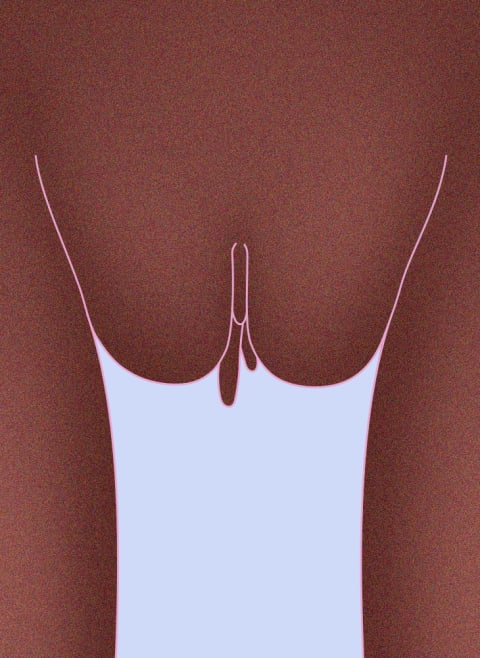
Curved outer lips
Some outer lips will have a curved magnet-like shape, meeting at the bottom. This shape will create a window in the middle revealing the inner lips.
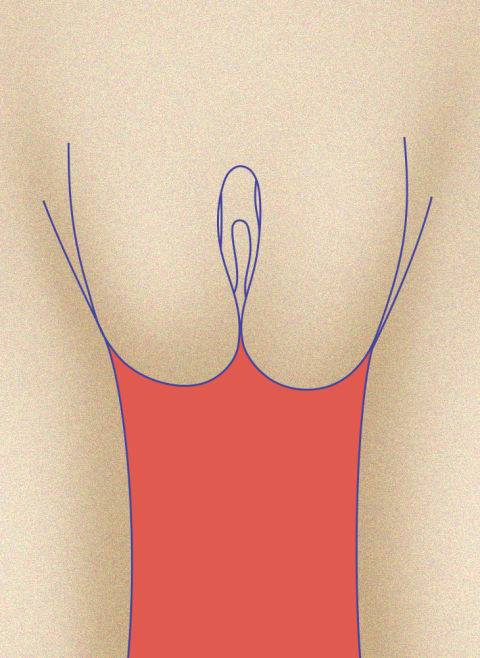
Prominent inner lips
This is when the inner lips are larger than the outer lips, and it's a relatively common type of vulva. Some people may experience discomfort using tampons, having sex, or wearing tight clothing when their inner lips extend beyond the outer lips, Durrett says, while other people with this vulva type aren't bothered at all.
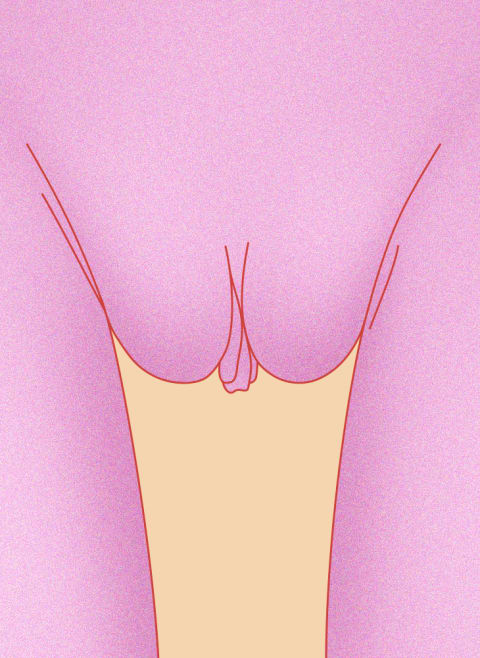
Prominent outer lips
This simply means the outer lips are larger than the inner lips. They tend to sit lower on the vulva and may extend beyond underwear. Both full and puffy outer lips, as well as thin and loose outer lips, can fit into this category.
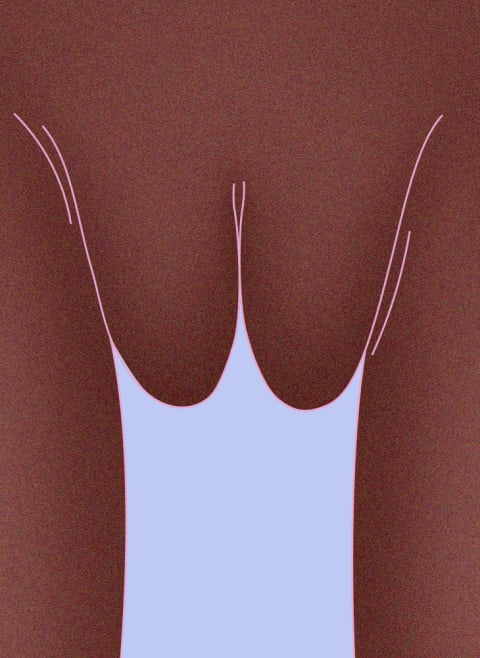
Long, dangling inner lips
This is one way prominent inner lips might appear, wherein when the inner lips are longer than the outer lips and seem to dangle from the vulva, Irobunda says. These inner lips can be an inch long or longer, or they may look like there's extra skin or folds.
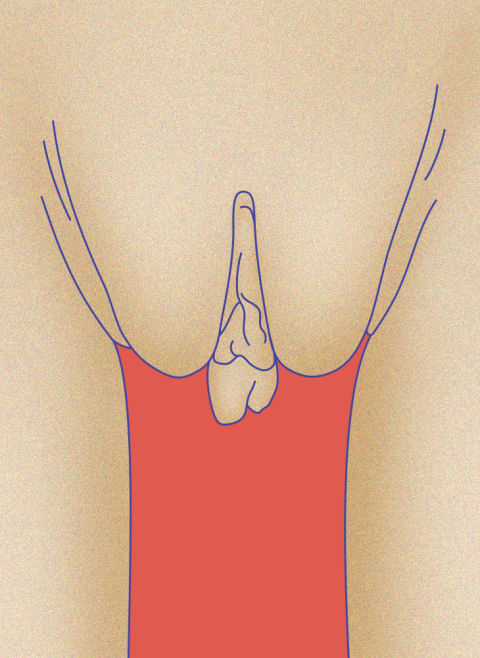
Long, dangling outer lips
This is when the outer lips are longer than the inner lips (opposite to the type above). This is a form of prominent outer lips, though this structure, in particular, tends to involve thinner or looser outer lips that may extend beyond underwear.
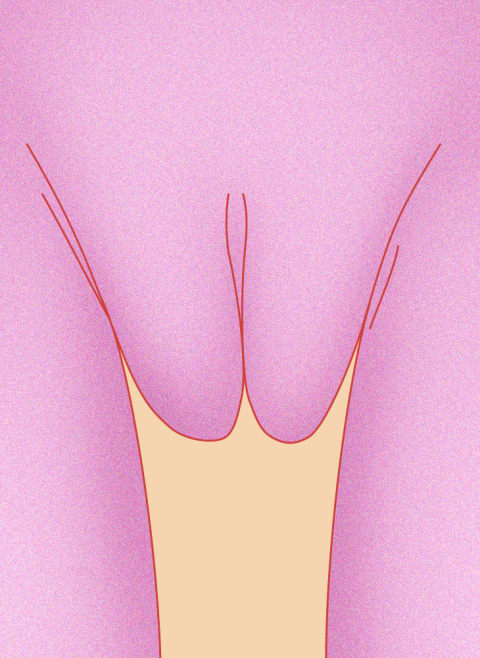
Small, closed lips
In some vulvas, "the labia majora and the labia minora blend together so it's not really like two sets of lips; it's more like one," Durrett says. While they are technically two separate parts, the outer lips are closed so that they conceal the inner lips. Small, closed outer lips are commonly seen in porn, though it's actually a relatively uncommon type of vulva.
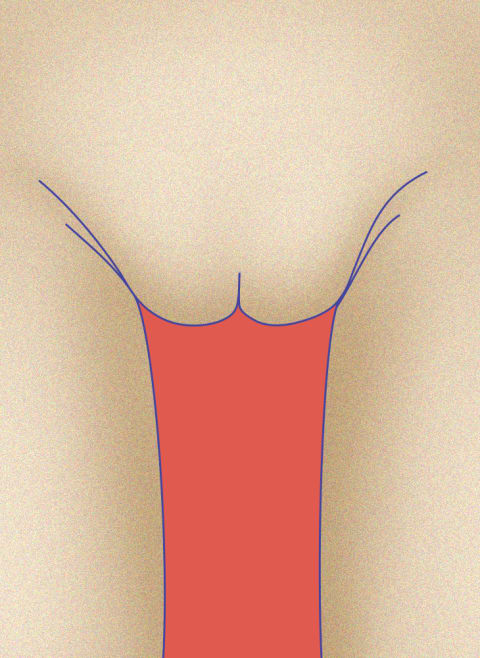
Small, open lips
With this type of vulva, the outer lips are still small, but they're set farther apart making them appear slightly open.
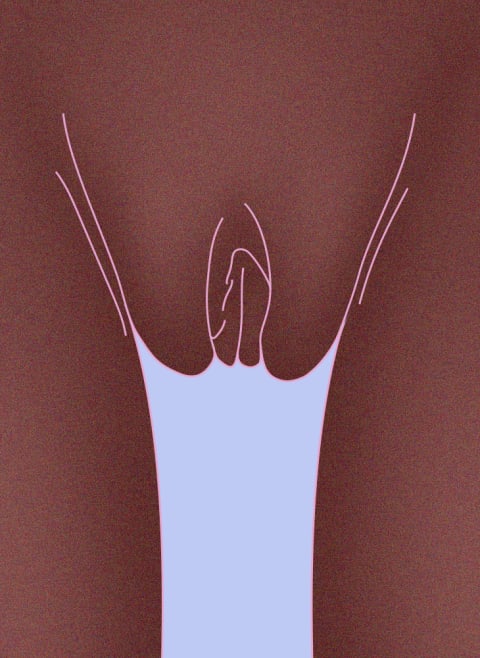
Visible inner lips
For this type of vulva, the outer lips appear curved or pulled outward, leaving almost a window for the inner lips to peek through.
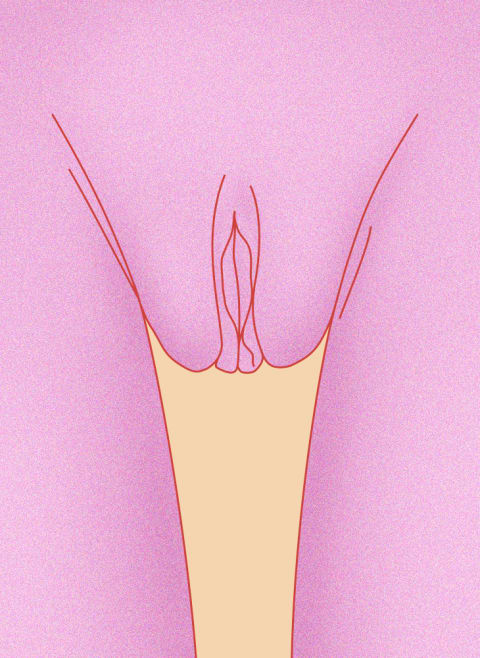
For more examples of what vulvas can look like, check out The Vulva Gallery, a project where illustrator Hilde Atalanta paints portraits of real people's vulvas.
What color should it be?
The outer labia are generally the same color as the skin or slightly darker, functional OB/GYN Wendie Trubow, M.D., says. The inner labia might be pink, while others might be reddish, brown, or purple in color. "If someone has vitiligo and it affects the vagina, that would cause the person not to have any pigmentation on their labia, and it would be white," Trubow adds.
The labia could undergo slight variations in color for different reasons. "Some people may notice that the labia may become a little redder or larger in appearance when aroused because of the increase in blood supply," Irobunda explains. That's perfectly normal and shouldn't be cause for concern.
However, irritation from fragrances may also lead to a redness or darkening of the labia, Irobunda tells mbg. If that occurs, stop using products with fragrance, including scented body wash, scented tampons, and even scented laundry detergent, and consult with a gynecologist.
"The vagina itself is usually a medium to dark pinkish-red," Durrett says. If it's a vibrant, bright red, that's typically a sign of inflammation, she adds.
Variations in pubic hair.
Just like everything else down there, pubic hair will vary from person to person in terms of thickness, growth patterns, and pubic hair color (which does not always match the hair on your head). The variations here are a combination of grooming, genetics, developmental stages, and response to medical conditions, Gilberg-Lenz says.
Around puberty, pubic hair will begin to grow due to hormonal changes1. With age, Durrett says the pubic hair may begin to thin and become gray.
Some people will only experience hair growth on the mons pubis and the outer lips, stopping at a natural bikini line. Others might see growth beyond the bikini line, either onto the thighs, beyond the mons pubis toward the belly button, and toward or surrounding the anus, Gilberg-Lenz says. "None of this is necessarily abnormal, but sudden changes in an otherwise healthy adult could signal a need for medical attention."
For example, hair loss could occur due to a nutritional deficiency or hormonal imbalance, she explains. If this is happening suddenly, it's best to consult with an OB/GYN.
Vagina FAQs:
What should it smell like?
All vaginas will have their own unique odor. Sweat and menstruation can change the smell of the vagina, but it should return to normal after a shower. According to Irobunda, odor can also be altered slightly due to changes in diet, soaps you're using, and even different sexual partners.
"However, the odor shouldn't be bad smelling. If it is, then you should go see a medical provider to get examined," she notes. A concerning odor is fish-like or something you would consider objectively bad, she explains. This could indicate an imbalance in the vaginal microbiome, which could result in infection.
What does healthy discharge look like?
"Healthy discharge can come in a variety of colors," Irobunda says, including clear or white, and it may even have a slight brown tinge following a period. It can vary in viscosity throughout the month, Durrett adds. It's thicker when you ovulate and becomes thinner during the other parts of your menstrual cycle.
Signs of unhealthy discharge include green or yellow coloring or white with a cottage-cheese-like consistency. These can indicate a yeast infection or overgrowth and will usually be accompanied by itching and burning, Irobunda says.
Should I be shaving?
Whether or not someone chooses to shave is a personal preference. That said, "Without the natural defense of the hair, its oils, and naturally occurring bacteria, you may be more susceptible to infection, and of course, shaving bumps or folliculitis," Gilberg-Lenz says. Waxing, sugaring, or trimming are other common hair-removal options if you prefer a groomed vulva.
What do I do about ingrown hair or bumps?
The vulva, like any other areas of the skin, can have moles, varicose veins, warts, ingrown hairs, and sebaceous cysts that look like acne, Durrett says. "Melanoma is the second most common kind of cancer of the vulva or vagina," she adds, so it's always recommended to have your OB/GYN check moles, just as you would at the dermatologist.
Genital warts are a symptom of human papillomavirus (HPV), a sexually transmitted infection (STI). The warts can be visible on the vulva but may also be inside of the cervix or the anus. If you're not able to see these warts but are experiencing pain or bleeding during sex, that could be a sign of an undiagnosed STI. Always consult with a doctor if you have visible warts or experience these symptoms.
If the bumps are a result of ingrown hairs, Gilberg-Lenz recommends exfoliating but only on the hairy or external-most portion of the vulva, followed by a gentle natural moisturizer. "Again, only on the outside, not inner labia or vagina," she says.
How to care for your vagina.
The best way to clean your vagina is, well, to not clean your vagina. "It's a beautiful microcosm and cleans itself," Trubow says. The external-most part of the vulva, however, can be cleaned.
"If you want to use something other than water (which is definitely an acceptable way to clean the area), you can use a gentle, unscented soap," Irobunda says. "Vulvar skin is very sensitive, so you should try to use something that will not irritate it."
You should always be wary of products telling you that you are not OK as is, Gilberg-Lenz says. In other words, avoid products claiming to "fix" the odor or appearance of your vagina, she explains. If you have a concerning odor, itching, or burning sensation, see your doctor. That's generally the sign of an infection, which means it can't be fixed with soap.
Takeaways.
"Labias are like people," Trubow says. "They literally come in all different varieties (and that's normal!). Some are narrow, some are thicker, some are longer, some are shorter." If you've never taken the time to get to know yours, grab a handheld mirror and take a look.
Understanding your baseline scent, color, and overall appearance (aka your version of "normal") can help you recognize when something is off.
Watch Next
Enjoy some of our favorite clips from classes
Enjoy some of our favorite clips from classes
What Is Meditation?
Mindfulness/Spirituality | Light Watkins
Box Breathing
Mindfulness/Spirituality | Gwen Dittmar
What Breathwork Can Address
Mindfulness/Spirituality | Gwen Dittmar
The 8 Limbs of Yoga - What is Asana?
Yoga | Caley Alyssa
Two Standing Postures to Open Up Tight Hips
Yoga | Caley Alyssa
How Plants Can Optimize Athletic Performance
Nutrition | Rich Roll
What to Eat Before a Workout
Nutrition | Rich Roll
How Ayurveda Helps Us Navigate Modern Life
Nutrition | Sahara Rose
Messages About Love & Relationships
Love & Relationships | Esther Perel
Love Languages
Love & Relationships | Esther Perel
What Is Meditation?
Box Breathing
What Breathwork Can Address
The 8 Limbs of Yoga - What is Asana?
Two Standing Postures to Open Up Tight Hips
How Plants Can Optimize Athletic Performance
What to Eat Before a Workout
How Ayurveda Helps Us Navigate Modern Life
Messages About Love & Relationships
Love Languages
Advertisement

New Study Confirms The 3 Habits That Age Your Brain Faster
Molly Knudsen, M.S., RDN
















